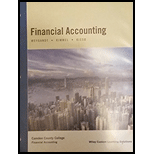
Concept explainers
(a)
Accounts receivable:
Accounts receivable refers to the amounts to be received with interest, within a short period from customers upon the sale of goods, and services on account. In other words, accounts receivable are amounts customers owe to the business. Accounts receivable is an asset of a business.
Bad debt expense:
Bad debt expense is an expense account. The amounts of loss incurred from extending credit to the customers are recorded as bad debt expense. In other words, the estimated uncollectible accounts receivable are known as bad debt expense.
Percentage-of-receivables basis:
It is a method of estimating the
Allowance method:
It is a method for accounting bad debt expense, where uncollectible accounts receivables are estimated, and recorded at the end of particular period. Under this method, bad debts expenses are estimated, and recorded prior to the occurrence of actual bad debt, in compliance with matching principle by using the allowance for doubtful account.
Direct write-off method:
This method does not make allowance or estimation for uncollectible accounts, instead this method directly write-off the actual uncollectible accounts, by debiting bad debt expense, and by crediting accounts receivable. Under this method, accounts would be written off only when the receivables from a customer remain uncollectible.
The amount to be reported as bad debt expense, if Company M uses the direct write-off method of accounting for bad debts.
(b)
The amount of bad debts expense would be recorded by Company M.
(c)
The amount of bad debt expense that would be recorded by Company M.
(d)
The amount of bad debt expense that would be recorded by Company M.
(e)
To describe: The weakness of reporting bad debt expense under direct write-off method.
Want to see the full answer?
Check out a sample textbook solution
Chapter 8 Solutions
FINANCIAL ACCOUNTING W/WILEY+ >IP<
- Calculate the labor variancearrow_forwardCompute the total overhead variance.arrow_forwardComputer Zone sells laptops. During August 2023, it sold 320 laptops at a $1,850 average price each. The August 2023 budget included sales of 350 laptops at an average price of $1,750 each. Compute the sales price variance and the sales volume variance for August 2023.arrow_forward
- Please provide the answer to this general accounting question using the right approach.arrow_forwardCalculate the labor variance.arrow_forwardHorngren's Financial & Managerial Accounting: The Managerial Chapters, 8th Edition E-M:8-18 Defining the benefits of setting cost standards and calculating materials and labor variancesColton, Inc. produced 1,000 units of the company’s product in 2025. The standard quantity allowed of direct materials was three yards of cloth per unit at a standard cost of $1.05 per yard. The accounting records showed that 2,600 yards of cloth were used and the company paid $1.10 per yard. Standard time was two direct labor hours per unit at a standard rate of $16.00 per direct labor hour. Employees worked 1,400 hours and were paid $15.50 per hour. Requirements1.What are the benefits of setting cost standards? 2. Calculate the direct materials cost variance and the direct materials efficiency variance as well as the direct labor cost and efficiency variances. 2. DM Eff. Var. $420 Farrow_forward
- From Horngren's Financial & Managerial Accounting: The Managerial Chapters, 8th Edition E-M:8-16 Preparing a flexible budget performance report. Complete the performance report. ARVIN COMPANY Flexible Budget Performance Report For the Year Ended July 31, 2025 Actual Results Flexible Budget Var Flexible Budget Sales Vol Variance Static Budget Units 39,000 a 39,000 3,000 g Sales Revenue $ 218,000 b $ 218,000 $ 27,000 h Variable Expenses 84,000 c 81,000 10,000 i Contribution Margin $ 134,000 d $ 137,000 $ 17,000 j Fixed Expenses 108,000 e 101,000 - k Operating Income $ 26,000 f $ 36,000 $ 17,000 l…arrow_forwardI need help answering the following question below for my class discussion. After taking Managerial Accounting, you like the discipline and the potential it presents for your future career advancement, so you take the Certified Management Accountant exam and pass it with flying colors. To get my career going, I am considering starting a consulting business, advising other enterprises on managerial accounting related issues (internal controls, how to organize the responsibility centers and how to evaluate them, automate their system to track managerial data including production costs, how to set up the budgeting system and how to control costs, etc.). To organize my consulting business, I need to look up on the form of business to organize my consulting firm under. Specifically, I want to consider the form of business from the perspectives of liability (including mutual agency), taxes, control. Which form of business should I choose? justifing my choice and being creative with my…arrow_forwardNonearrow_forward
- https://investor.exxonmobil.com/sec-filings/annual-reports/content/0000034088-25-000010/0000034088-25-000010.pdf Use link to help me answer my questions please in picturearrow_forwardPlease provide the accurate answer to this general accounting problem using appropriate methods.arrow_forwardGeneral accounting questionarrow_forward

 AccountingAccountingISBN:9781337272094Author:WARREN, Carl S., Reeve, James M., Duchac, Jonathan E.Publisher:Cengage Learning,
AccountingAccountingISBN:9781337272094Author:WARREN, Carl S., Reeve, James M., Duchac, Jonathan E.Publisher:Cengage Learning, Accounting Information SystemsAccountingISBN:9781337619202Author:Hall, James A.Publisher:Cengage Learning,
Accounting Information SystemsAccountingISBN:9781337619202Author:Hall, James A.Publisher:Cengage Learning, Horngren's Cost Accounting: A Managerial Emphasis...AccountingISBN:9780134475585Author:Srikant M. Datar, Madhav V. RajanPublisher:PEARSON
Horngren's Cost Accounting: A Managerial Emphasis...AccountingISBN:9780134475585Author:Srikant M. Datar, Madhav V. RajanPublisher:PEARSON Intermediate AccountingAccountingISBN:9781259722660Author:J. David Spiceland, Mark W. Nelson, Wayne M ThomasPublisher:McGraw-Hill Education
Intermediate AccountingAccountingISBN:9781259722660Author:J. David Spiceland, Mark W. Nelson, Wayne M ThomasPublisher:McGraw-Hill Education Financial and Managerial AccountingAccountingISBN:9781259726705Author:John J Wild, Ken W. Shaw, Barbara Chiappetta Fundamental Accounting PrinciplesPublisher:McGraw-Hill Education
Financial and Managerial AccountingAccountingISBN:9781259726705Author:John J Wild, Ken W. Shaw, Barbara Chiappetta Fundamental Accounting PrinciplesPublisher:McGraw-Hill Education





